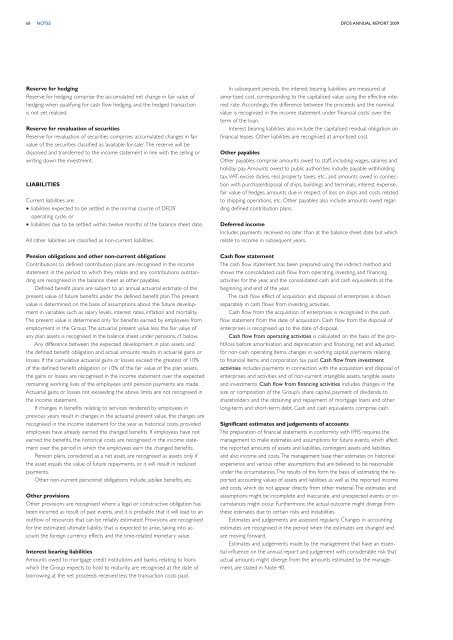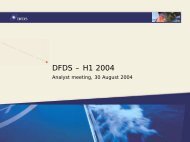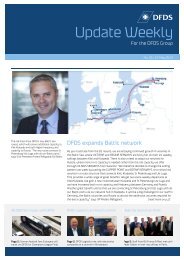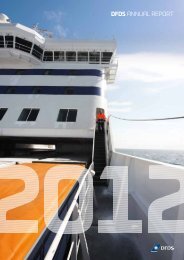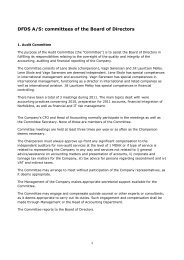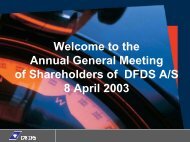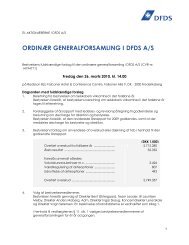English - DFDS
English - DFDS
English - DFDS
Create successful ePaper yourself
Turn your PDF publications into a flip-book with our unique Google optimized e-Paper software.
68 NOTEs<br />
<strong>DFDS</strong> annual report 2009<br />
Reserve for hedging<br />
Reserve for hedging comprise the accumulated net change in fair value of<br />
hedging when qualifying for cash flow hedging, and the hedged transaction<br />
is not yet realised.<br />
Reserve for revaluation of securities<br />
Reserve for revaluation of securities comprises accumulated changes in fair<br />
value of the securities classified as ‘available-for-sale’. The reserve will be<br />
dissolved and transferred to the income statement in line with the selling or<br />
writing down the investment.<br />
Liabilities<br />
Current liabilities are:<br />
n liabilities expected to be settled in the normal course of <strong>DFDS</strong>’<br />
operating cycle, or<br />
n liabilities due to be settled within twelve months of the balance sheet date.<br />
All other liabilities are classified as non-current liabilities.<br />
Pension obligations and other non-current obligations<br />
Contributions to defined contribution plans are recognised in the income<br />
statement in the period to which they relate and any contributions outstanding<br />
are recognised in the balance sheet as other payables.<br />
Defined benefit plans are subject to an annual actuarial estimate of the<br />
present value of future benefits under the defined benefit plan. The present<br />
value is determined on the basis of assumptions about the future development<br />
in variables such as salary levels, interest rates, inflation and mortality.<br />
The present value is determined only for benefits earned by employees from<br />
employment in the Group. The actuarial present value less the fair value of<br />
any plan assets is recognised in the balance sheet under pensions, cf. below.<br />
Any difference between the expected development in plan assets and<br />
the defined benefit obligation and actual amounts results in actuarial gains or<br />
losses. If the cumulative actuarial gains or losses exceed the greatest of 10%<br />
of the defined benefit obligation or 10% of the fair value of the plan assets,<br />
the gains or losses are recognised in the income statement over the expected<br />
remaining working lives of the employees until pension payments are made.<br />
Actuarial gains or losses not exceeding the above limits are not recognised in<br />
the income statement.<br />
If changes in benefits relating to services rendered by employees in<br />
previous years result in changes in the actuarial present value, the changes are<br />
recognised in the income statement for the year as historical costs, provided<br />
employees have already earned the changed benefits. If employees have not<br />
earned the benefits, the historical costs are recognised in the income statement<br />
over the period in which the employees earn the changed benefits.<br />
Pension plans, considered as a net asset, are recognised as assets only if<br />
the asset equals the value of future repayments, or it will result in reduced<br />
payments.<br />
Other non-current personnel obligations include jubilee benefits, etc.<br />
Other provisions<br />
Other provisions are recognised where a legal or constructive obligation has<br />
been incurred as result of past events, and it is probable that it will lead to an<br />
outflow of resources that can be reliably estimated. Provisions are recognised<br />
for the estimated ultimate liability that is expected to arise, taking into account<br />
the foreign currency effects and the time-related monetary value.<br />
Interest bearing liabilities<br />
Amounts owed to mortgage credit institutions and banks, relating to loans<br />
which the Group expects to hold to maturity, are recognised at the date of<br />
borrowing at the net proceeds received less the transaction costs paid.<br />
In subsequent periods, the interest bearing liabilities are measured at<br />
amortised cost, corresponding to the capitalised value using the effective interest<br />
rate. Accordingly, the difference between the proceeds and the nominal<br />
value is recognised in the income statement under ‘financial costs’ over the<br />
term of the loan.<br />
Interest bearing liabilities also include the capitalised residual obligation on<br />
financial leases. Other liabilities are recognised at amortised cost.<br />
Other payables<br />
Other payables comprise amounts owed to staff, including wages, salaries and<br />
holiday pay. Amounts owed to public authorities include payable withholding<br />
tax, VAT, excise duties, real property taxes, etc., and amounts owed in connection<br />
with purchase/disposal of ships, buildings and terminals, interest expense,<br />
fair value of hedges, amounts due in respect of loss on ships and costs related<br />
to shipping operations, etc. Other payables also include amounts owed regarding<br />
defined contribution plans.<br />
Deferred income<br />
Includes payments received no later than at the balance sheet date but which<br />
relate to income in subsequent years.<br />
Cash flow statement<br />
The cash flow statement has been prepared using the indirect method and<br />
shows the consolidated cash flow from operating, investing, and financing<br />
activities for the year, and the consolidated cash and cash equivalents at the<br />
beginning and end of the year.<br />
The cash flow effect of acquisition and disposal of enterprises is shown<br />
separately in cash flows from investing activities.<br />
Cash flow from the acquisition of enterprises is recognised in the cash<br />
flow statement from the date of acquisition. Cash flow from the disposal of<br />
enterprises is recognised up to the date of disposal.<br />
Cash flow from operating activities is calculated on the basis of the profit/loss<br />
before amortisation and depreciation and financing, net and adjusted<br />
for non-cash operating items, changes in working capital, payments relating<br />
to financial items and corporation tax paid. Cash flow from investment<br />
activities includes payments in connection with the acquisition and disposal of<br />
enterprises and activities and of non-current intangible assets, tangible assets<br />
and investments. Cash flow from financing activities includes changes in the<br />
size or composition of the Group’s share capital, payment of dividends to<br />
shareholders and the obtaining and repayment of mortgage loans and other<br />
long-term and short-term debt. Cash and cash equivalents comprise cash.<br />
Significant estimates and judgements of accounts<br />
The preparation of financial statements in conformity with IFRS requires the<br />
management to make estimates and assumptions for future events, which affect<br />
the reported amounts of assets and liabilities, contingent assets and liabilities,<br />
and also income and costs. The management base their estimates on historical<br />
experience and various other assumptions that are believed to be reasonable<br />
under the circumstances. The results of this form the basis of estimating the reported<br />
accounting values of assets and liabilities as well as the reported income<br />
and costs, which do not appear directly from other material. The estimates and<br />
assumptions might be incomplete and inaccurate, and unexpected events or circumstances<br />
might occur. Furthermore, the actual outcome might diverge from<br />
these estimates due to certain risks and instabilities.<br />
Estimates and judgements are assessed regularly. Changes in accounting<br />
estimates are recognised in the period when the estimates are changed and<br />
are moving forward.<br />
Estimates and judgements made by the management that have an essential<br />
influence on the annual report and judgement with considerable risk that<br />
actual amounts might diverge from the amounts estimated by the management,<br />
are stated in Note 40.


